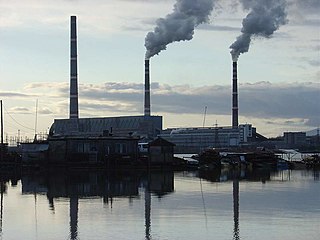
A carbon tax is a tax levied on the carbon emissions from producing goods and services. Carbon taxes are intended to make visible the hidden social costs of carbon emissions. They are designed to reduce greenhouse gas emissions by essentially increasing the price of fossil fuels. This both decreases demand for goods and services that produce high emissions and incentivizes making them less carbon-intensive. When a fossil fuel such as coal, petroleum, or natural gas is burned, most or all of its carbon is converted to CO2. Greenhouse gas emissions cause climate change. This negative externality can be reduced by taxing carbon content at any point in the product cycle.

John Russell Baird is a retired Canadian politician. He served as Minister of Foreign Affairs from 2011 to 2015 in the cabinet of Prime Minister Stephen Harper. He had been a member of the federal cabinet, in various positions, since 2006. Previously he was a provincial cabinet minister in Ontario during the governments of Premiers Mike Harris and Ernie Eves. Baird resigned from Harper's cabinet on February 3, 2015, and as a Member of Parliament on March 16, 2015.
The United Kingdom's Climate Change Programme was launched in November 2000 by the British government in response to its commitment agreed at the 1992 United Nations Conference on Environment and Development (UNCED). The 2000 programme was updated in March 2006 following a review launched in September 2004.
The Ministry of the Environment, Conservation and Parks is an Ontario government ministry responsible for protecting and improving the quality of the environment in the Canadian province of Ontario, as well as coordinating Ontario's actions on climate change. This includes administration of government programs, such as Ontario's Drive Clean and Clean Water Act. The ministry headquarters are located inside the Ontario Government Buildings.
The Global Warming Solutions Act of 2006, or Assembly Bill (AB) 32, is a California state law that fights global warming by establishing a comprehensive program to reduce greenhouse gas emissions from all sources throughout the state. AB32 was co-authored by Assemblymember Fran Pavley and Speaker of the California Assembly Fabian Nunez and signed into law by Governor Arnold Schwarzenegger on September 27, 2006.

The Sheffield Energy Recovery Facility, also known as the Energy from Waste Plant, is a modern incinerator which treats Sheffield's household waste. It is notable as it not only provides electricity from the combustion of waste but also supplies heat to a local district heating scheme, making it one of the most advanced, energy efficient incineration plants in the UK. In 2004, the district heating network prevented 15,108 tonnes of CO2 from being released from buildings across the city, compared to energy derived from fossil fuels. The incinerator is a 'static asset' owned by Sheffield City Council and operated by Veolia Environmental Services under a 35 year integrated waste management contract (IWMC)/PFI contract.

The United States produced 5.2 billion metric tons of carbon dioxide equivalent greenhouse gas (GHG) emissions in 2020, the second largest in the world after greenhouse gas emissions by China and among the countries with the highest greenhouse gas emissions per person. In 2019 China is estimated to have emitted 27% of world GHG, followed by the United States with 11%, then India with 6.6%. In total the United States has emitted a quarter of world GHG, more than any other country. Annual emissions are over 15 tons per person and, amongst the top eight emitters, is the highest country by greenhouse gas emissions per person.
The Climate Change and Emissions Management Amendment Act of the Canadian province of Alberta was the first law of its type to impose greenhouse gas cuts on large industrial facilities.

John Yap is a Canadian politician and former banker. He represented the electoral district of Richmond-Steveston in the Legislative Assembly of British Columbia from 2005 to 2020, as part of the BC Liberal caucus. During his time in government, he served as Minister of State for Climate Action, Minister Responsible for Multiculturalism, and Minister of Advanced Education, Innovation and Technology in the cabinets of premiers Gordon Campbell and Christy Clark.
The environmental policy of the Stephen Harper government was implemented when Stephen Harper was the Prime Minister of Canada from 2006 to 2015, under two minority governments until 2011 when the Conservative Party of Canada won a majority in the 2011 Canadian federal election. During the term of Stephen Harper, Canada's greenhouse gas emissions decreased from 730 to 723 Mt of carbon dioxide equivalent. In contrast, during the period from 1993 until 2006, under various Liberal governments, Canada's greenhouse gas emissions increased 617 to 730 Mt of carbon dioxide equivalent.

Canada was active in the negotiations that led to the Kyoto Protocol in 1997. The Liberal government that signed the accord in 1997 ratified it in parliament in 2002. Canada's Kyoto target was a 6% total reduction in greenhouse gas (GHG) emissions by 2012, compared to 1990 levels of 461 megatonnes (Mt). Despite signing the accord, greenhouse gas emissions increased approximately 24.1% between 1990 and 2008. In 2011, Conservative Prime Minister Stephen Harper withdrew Canada from the Kyoto Protocol.

Greenhouse gas emissions by Australia totalled 533 million tonnes CO2-equivalent based on greenhouse gas national inventory report data for 2019; representing per capita CO2e emissions of 21 tons, three times the global average. Coal was responsible for 30% of emissions. The national Greenhouse Gas Inventory estimates for the year to March 2021 were 494.2 million tonnes, which is 27.8 million tonnes, or 5.3%, lower than the previous year. It is 20.8% lower than in 2005. According to the government, the result reflects the decrease in transport emissions due to COVID-19 pandemic restrictions, reduced fugitive emissions, and reductions in emissions from electricity; however, there were increased greenhouse gas emissions from the land and agriculture sectors.

The environmental effects of paper are significant, which has led to changes in industry and behaviour at both business and personal levels. With the use of modern technology such as the printing press and the highly mechanized harvesting of wood, disposable paper became a relatively cheap commodity, which led to a high level of consumption and waste. The rise in global environmental issues such as air and water pollution, climate change, overflowing landfills and clearcutting have all lead to increased government regulations. There is now a trend towards sustainability in the pulp and paper industry as it moves to reduce clear cutting, water use, greenhouse gas emissions, fossil fuel consumption and clean up its influence on local water supplies and air pollution.

Climate change in Canada has had large impacts on the country's environment and landscapes. These events are likely to become even more frequent and severe in the future due to the continued release of greenhouse gases into the atmosphere. The number of climate change–related events, such as the 2021 British Columbia Floods and an increasing number of forest fires, has become an increasing concern over time. Canada's annual average temperature over land has warmed by 1.7 degrees Celsius since 1948. The rate of warming is even higher in Canada's north, the Prairies, and northern British Columbia. The country's precipitation has increased in recent years and extreme weather events have become more common.
The climate change policy of the United States has major impacts on global climate change and global climate change mitigation. This is because the United States is the second largest emitter of greenhouse gasses in the world after China, and is among the countries with the highest greenhouse gas emissions per person in the world. Cumulatively, the United States has emitted over a trillion metric tons of greenhouse gases, more than any country in the world.
The Kyoto Protocol was an international treaty which extended the 1992 United Nations Framework Convention on Climate Change. A number of governments across the world took a variety of actions.

Green economy policies in Canada are policies that contribute to transitioning the Canadian economy to a more environmentally sustainable one. The green economy can be defined as an economy, "that results in improved human well-being and social equity, while significantly reducing environmental risks and ecological scarcities." Aspects of a green economy would include stable growth in income and employment that is driven by private and public investment into policies and actions that reduce carbon emissions, pollution and prevent the loss of biodiversity.
Carbon pricing in Canada is implemented either as a regulatory fee or tax levied on the carbon content of fuels at the Canadian provincial, territorial or federal level. Provinces and territories of Canada are allowed to create their own system of carbon pricing as long as they comply with the minimum requirements set by the federal government; individual provinces and territories thus may have a higher tax than the federally mandated one but not a lower one. Currently, all provinces and territories are subject to a carbon pricing mechanism, either by an in-province program or by one of two federal programs. As of April 2023 the federal minimum tax is set at CA$65 per tonne of CO2 equivalent, set to increase to CA$170 in 2030.
The Canadian province of Alberta faces a number of environmental issues related to natural resource extraction—including oil and gas industry with its oil sands—endangered species, melting glaciers in banff, floods and droughts, wildfires, and global climate change. While the oil and gas industries generates substantial economic wealth, the Athabasca oil sands, which are situated almost entirely in Alberta, are the "fourth most carbon intensive on the planet behind Algeria, Venezuela and Cameroon" according to an August 8, 2018 article in the American Association for the Advancement of Science's journal Science. This article details some of the environmental issues including past ecological disasters in Alberta and describes some of the efforts at the municipal, provincial and federal level to mitigate the risks and impacts.

The Greenhouse Gas Pollution Pricing Act is a Canadian federal law establishing a set of minimum national standards for carbon pricing in Canada to meet emission reduction targets under the Paris Agreement. It was passed as Part 5 of the Budget Implementation Act, 2018, No. 1 – an omnibus budget bill – during the 42nd Parliament of Canada. The law came into force immediately upon receiving royal assent on June 21, 2018.











